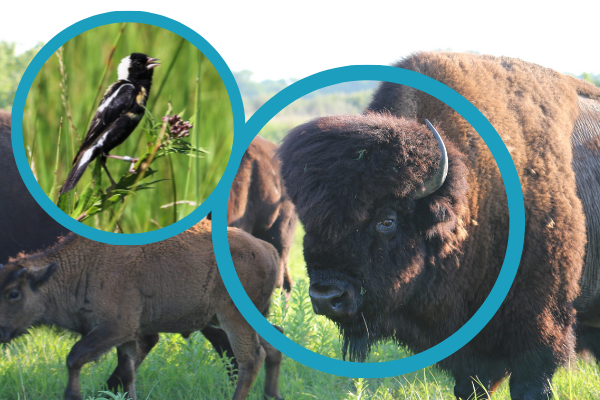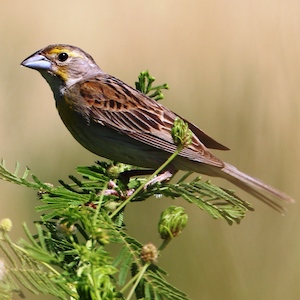Bobolinks and American bison are both native to North America’s grasslands and have lived alongside each other for tens of thousands of years, so of course they’re compatible! Right? Unfortunately, it’s not that simple, because today’s bison are not the same as the bison of yesteryear. Or rather the bison themselves haven’t changed much, but the way they roam has changed dramatically.
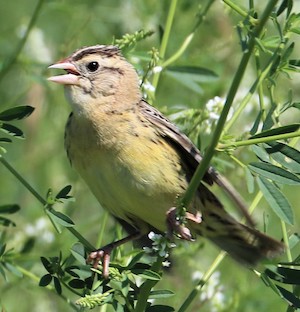
A female Bobolink. Photo by Nico Arcilla.
A new study using data from the Monitoring Avian Productivity and Survivorship (MAPS) program examines how bison reintroduction at a private nature preserve in Nebraska affected the Bobolink (Dolichonyx oryzivorus) population. The study by Rachel Kaplan of the International Bird Conservation Partnership with colleagues from the Crane Trust, the University of Missouri, the Swedish University of Agricultural Sciences, Southern Illinois University, the US Fish and Wildlife Service and the University of Nebraska was published last month in the journal Animals.
The researchers used MAPS data to compare the abundance and productivity (number of young produced) of Bobolinks on the preserve before and after bison reintroduction in 2015. Prior to the reintroduction, periodic haying and controlled burning occurred on certain areas of the preserve, which is managed by the Crane Trust. In addition, cattle were rotationally grazed on the preserve (rotated on and off certain areas to prevent overgrazing). These practices helped prevent encroachment of woody vegetation to maintain grasslands, and they continued after bison arrived. In contrast to cattle, reintroduced bison were not rotationally grazed but instead confined to a section of the preserve.
The researchers hypothesized that the reintroduction of bison, a native herbivore and keystone grassland species, would improve the habitat for Bobolinks and predicted that Bobolink abundance and productivity would improve post-reintroduction. Unfortunately, that’s not what happened. Bobolink abundance and productivity declined steeply in areas occupied by the bison, while they remained stable in adjacent areas with no bison. We talked about these results and what we can learn from them with Dr. Nico Arcilla, a co-author of the study and a biologist with the International Bird Conservation Partnership and the University of Nebraska – and a longtime friend and partner of IBP.
Can you explain the difference between how bison grazed historically (prior to European settlement) and how they grazed in your study area? How would these differences in grazing affect Bobolinks?
Early 19th century travelers and settlers in the Great Plains described herds of bison that stretched for miles and roamed freely across grasslands, migrating to different feeding areas in summer and winter. At that time, bison would likely have had intense impacts on grasslands for limited periods of time before they moved on, allowing the grassland to recover and regenerate. Bobolinks arriving on their summer breeding grounds would likely have chosen nesting locations that avoided close proximity to bison. Today, where bison are confined to limited areas, or kept in high densities year-round, they may have transformative impacts on grasslands. Overgrazing and trampling can in turn be detrimental to birds that need significant grassland cover to protect their nests and chicks, like Bobolinks, Dickcissels, and Henslow’s Sparrows.
Why can't we just manage grazing in bison the same way we do in cattle?
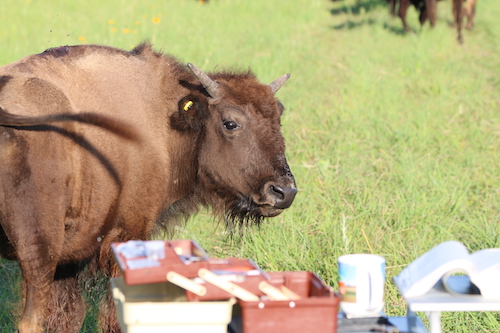
Bison graze near the MAPS banding station. Photo by Nico Arcilla.
People with experience managing both cattle and bison say it’s better to forget everything you know about cattle rather than expect it to apply to bison. Bison are bigger, heavier, and more dangerous to people than cattle; if bison feel threatened or harassed, they can gore or trample people in an effort to defend themselves. Despite their bulk, bison can also jump over six-foot fences, run as fast as horses, and stampede through fences if they are motivated to do so. That means from a management perspective, handling bison is much more dangerous and risky than handling cattle. Cattle domestication started over 10,000 years ago and cattle have been selected over the years for traits including manageability. Bison, by contrast, have had relatively little time to adapt to domestication. Whereas cattle may be rounded up and moved from one location to another in rotational grazing systems, this may not be so simple or straightforward with bison.
How important was the MAPS data for this study?
We could not have done this study without MAPS data. Nine years of MAPS data provided us with a rich source of information that allowed us to quantify and compare both adult and juvenile bird abundance over time in response to bison reintroduction as well as many other factors that affect birds. There are very few quantitative studies on birds’ responses to bison reintroductions, and none (to our knowledge) that considered both abundance and productivity together before this one, so we felt very lucky to have had the opportunity to do so.
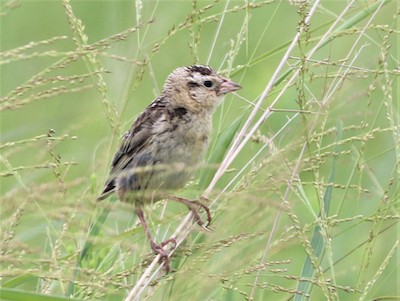
A juvenile Bobolink. Photo by Nico Arcilla.
When the first MAPS data was collected in this area, I don’t think the biologists doing so could have imagined that any of their sites would host bison reintroductions. When I was invited to establish a songbird research program right after they had reintroduced bison, we realized that using the older MAPS data as a baseline would provide an excellent way to measure the effects of the bison reintroduction on birds. A lot of other research had been done in this area in the past, including bird counts and nest searches, but we didn’t have enough documentation of these efforts to allow us to replicate them. MAPS data provided the baseline we needed to make a direct comparison between bird abundance and productivity before and after bison reintroduction, as well as in neighboring grasslands where bison were not reintroduced.
How did this study come about and what do you hope people learn from it?
Many people’s hard work over a considerable time period made this study possible. Our goal was to assess the outcomes of grassland conservation strategies in the context of a changing climate as well as to quantify the effects of a bison reintroductions on birds, which is a subject we know very little about. One of the bird biologists who ran the Crane Trust MAPS program in the first part of our study period (2002-2007) was Dr. Daniel Kim, who had relocated by the time I started my field work for this study, and now works for the US Fish and Wildlife Service. I hadn’t known him before we resumed the Crane Trust MAPS program in 2017, but he was kind enough to respond when we reached out to him for more information and we stayed in touch. By 2019 it was clear that the bird capture rates in his time were much higher than what we had found, including for Bobolinks in particular, and we realized we were documenting a bird decline. We had no idea then whether this reflected a larger decline in the region or whether it might be specifically related to any local changes at the Crane Trust.
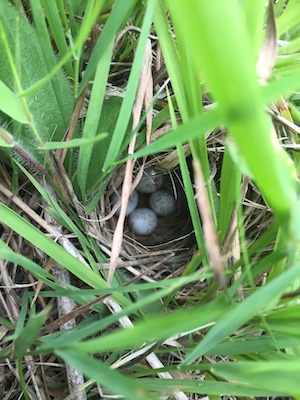
Bobolink nest on the ground and need sufficient vegetation to conceal their nests. Photo by Nico Arcilla.
Our finding that bison appeared to be driving the Bobolink decline came as a complete surprise. For Bobolinks, this decline was specifically and only occurring in the bison reintroduction area, and the decline was even more severe for juveniles than it was for adults, suggesting that reproductive success was especially impacted. A connection between Bobolink declines and bison was just about the last thing we expected to find, and certainly not what we wanted! The mission of the Crane Trust is protecting habitat for migratory birds, so when the bison were brought in, the hope was that they would improve bird habitat. Protected grasslands are precious and ideally teeming with native wildlife. Reintroducing bison was expected to be a “win-win scenario” for the bison as well as the birds. But the situation we found evokes that saying “you can’t go home again,” in the sense that we can bring bison “home” to the places their ancestors lived, but the circumstances surrounding them may be very different now.
There is a lot of excitement about bison reintroductions. Bison are a symbol of hope and resilience for many people, and an iconic animal that people are thrilled to see. The current conservation prospects for bison are very good, with many groups and individuals heavily invested in reintroducing them to more areas. Bobolink populations, on the other hand, are headed in the opposite direction and desperately need safe, productive grasslands where they can nest and raise their chicks. Bobolinks are also highly charismatic birds in urgent need of protection. When I think of these birds traveling thousands of miles to return to the grasslands where they hoped to nest, only to find them degraded or unusable, it's heartbreaking. Collecting this kind of data on bison reintroductions is important to inform management so that we are always testing our hypotheses and informing conservation efforts, according to what we find.
In conservation, it’s very important to check our expectations against whatever realities we find and adjust our actions accordingly. We hope that this research will inform changes in land management for the conservation of Bobolinks and other migratory birds, both in our study area and in other areas where bison are reintroduced. Other research suggests that grasslands with lower bison densities have a greater chance of being compatible with grassland bird conservation. This means that in bison reintroduction areas, if land managers take care to cap bison densities at a certain number per land area, other wildlife, including Bobolinks and other birds, will have a greater chance to thrive.
Continuing to study bison reintroductions and their effects on other wildlife is important, as such information is scarce and very much needed. This research demonstrates the value of collecting data on conservation outcomes rather than simply assuming that a particular strategy will have the desired result. Our findings provide a basis for conservation action and a cautionary tale for other bird conservation areas. We hope they will help the conservation of Bobolinks and other birds of conservation concern that help make American grasslands so magical. Using adaptive management, we can always be prepared to take bad news, such as the unfortunate findings of our study, and turn it into good news through informed action.
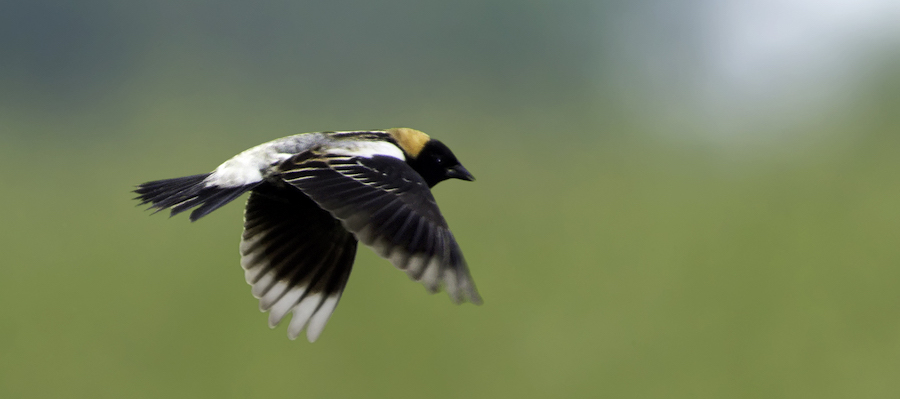
A male Bobolink in flight. Photo by Kelly Colgan Azar.


